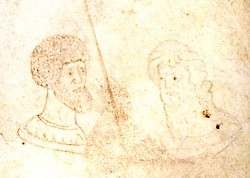Ptolemy's Canon
Ptolemy's Canon: list of rulers of ancient Babylonia and the Near East, used by the astronomer Ptolemy of Alexandria to date astronomical phenomena.

Before the Christians, who wanted a correct computation of the Easter date, created a common era for the study of chronology, people used regnal years or lists of eponymous magistrates to date events. For example, the Bible mentions that the Babylonian king Nebuchadnezzar captured Jerusalem 'in his eighteenth year as king', and Julius Caesar defeated the Helvetians when Lucius Calpurnius Piso and Aulus Gabinius were consuls. Modern scholars, employing the common era, call these years 587/586 and 58 BCE (or BCE).
The astronomer Ptolemy of Alexandria, who lived in the second century CE (or AD, used the system of regnal years and has handed down to us an important list of kings. It is called the Canon and has been preserved in several astronomical texts by later authors, which usually continue the list up to their own time. Because they were only interested in dating astronomical phenomena, kings who died during a certain year were usually allowed to give their name to the entire year, and the next ruler is supposed to have ascended to the Babylonian throne on the first day of the new year. (Kings who reigned for less than one year are ignored.)
This brief document, which is based on astronomical information from ancient Babylon, is still the backbone of the chronology of the ancient Near East. Its essential correctness has been corroborated by the Uruk King List, the Astronomical Diaries, and Egyptian data (like dated papyri). Here are the forty-three first names of Ptolemy's list (different colors indicate the Assyrian, Babylonian, Persian, Macedonian, and Ptolemaic kings):
|
|
|
years |
(simplified) |
|
|
| 1 | Nabonassaros | Nabû-Nasir |
|
|
|
| 2 | Nadios | Nabû-nadin-zer |
|
|
|
| 3 | Chinzer and Poros | Tiglath-Pileser III |
|
|
|
| 4 | Iloulaios | Šalmaneser V |
|
|
|
| 5 | Mardokempados | Marduk-apla-iddina II |
|
|
|
| 6 | Arkeanos | Sargon II |
|
|
|
| 7 | Without kings | note |
|
|
|
| 8 | Bilibos | Bêl-ipni |
|
|
|
| 9 | Aparanadios | Aššur-nadin-šumni |
|
|
|
| 10 | Rhegebelos | Nergal-ušezib |
|
|
|
| 11 | Mesesimordakos | Mušezib-Marduk |
|
|
|
| 12 | Without kings | note |
|
|
|
| 13 | Asaradinos | Esarhaddon |
|
|
|
| 14 | Saosdouchinos | Šamaš-šuma-ukin |
|
|
|
| 15 | Kineladanos | Kandalanu |
|
|
|
| 16 | Nabopolassaros | Nabopolassar |
|
|
|
| 17 | Nabokolassaros | Nebuchadnezzar II |
|
|
|
| 18 | Illoaroudamos | Amel-Marduk |
|
|
|
| 19 | Nerigasolassaros | Neriglissar |
|
|
|
| 20 | Nabonadios | Nabonidus |
|
|
|
| 21 | Kyros | Cyrus the Great |
|
|
|
| 22 | Kambysos | Cambyses II |
|
|
|
| 23 | Dareios the First | Darius I the Great |
|
|
|
| 24 | Xerxes | Xerxes I |
|
|
|
| 25 | Artaxerxes the First | Artaxerxes I Makrocheir |
|
|
|
| 26 | Dareios the Second | Darius II Nothus |
|
|
|
| 27 | Artaxerxes the Second | Artaxerxes II Mnemon |
|
|
|
| 28 | Ochos | Artaxerxes III Ochus |
|
|
|
| 29 | Arogos | Artaxerxes IV Arses |
|
|
|
| 30 | Dareios the Third | Darius III Codomannus |
|
|
|
| 31 | Alexandros the Macedonian | Alexander the Great |
|
|
|
| 32 | Philipposnote | Philip III Arridaeus |
|
|
|
| 33 | The other Alexandros | Alexander IV |
|
|
|
| 34 | Ptolemaios, son of Lagos | Ptolemy I Soter |
|
|
|
| 35 | Philadelphos | Ptolemy II Philadelphus |
|
|
|
| 36 | Euergetes | Ptolemy III Euergetes |
|
|
|
| 37 | Philopator | Ptolemy IV Philopator |
|
|
|
| 38 | Epiphanes | Ptolemy V Epiphanes |
|
|
|
| 39 | Philometor | Ptolemy VI Philometor |
|
|
|
| 40 | Euergetes the Second | Ptolemy VIII Euergetes |
|
|
|
| 41 | Soter | Ptolemy IX Soter |
|
|
|
| 42 | Dionysos Neos | Ptolemy XII Auletes |
|
|
|
| 43 | Kleopatra | Cleopatra VII Philopator |
|
|
|